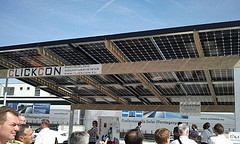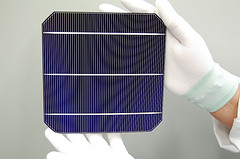By Rivka Borochov
Thirty-five years ago, Russian Jewish scientists Lev Kreinin and Nelly Brodin cooked up a theoretical idea for the Russian space agency to collect energy from the sun to power satellites: a bifacial, or double-sided, solar panel. Twenty years ago, Kreinin and Brodin immigrated to Israel with their know-how.
After partnering with Prof. Naftali Eisenberg from Jerusalem in 2007, the new solar energy company bSolar was created.
The company has since raised $10 million in funding; bought a production plant in Germany where it is manufacturing its bifacial solar cells; and entered the German, Japanese and Israeli markets. According to CEO Yossi Kofman, bSolar’s solution promises at least a 20 percent efficiency boost over the current and popular photovoltaic systems on the market, while production costs remain on par with solar panels that collect power from only one side.
The bSolar technology becomes most competitive when used in places where the area of photovoltaics is limited (think rooftops) but it can be used on ground-based applications or in building-integrated photovoltaics, where solar panels become part of a building’s façade or roof. bSolar could also collect power from dormant structures like sound barriers and carports.

The bifacial solar panels in an installation
Any additional costs for using bSolar’s bifacial photovoltaic (PV) solar cells are offset by the fact that bSolar can squeeze out more electricity per cell at a standard cell production cost. This lowers the industry’s levelized cost of electricity (LCOE), doubles the internal rate of return for the project and cuts payback time, Kofman says.
For larger solar panel projects, all these figures are meaningful, especially when renewables need to meet the bottom line and benefit the planet.
The other side of the record
The name for bSolar was inspired by the B-side of the phonograph record. “This is one of the reasons, but ‘b’ is also for boron, the material that we use on the backside of the panel,” says Kofman, who is currently raising a few million dollars to expand R&D and business efforts.
Several companies are planning to embed bSolar’s technology into their supply chain, including Solarpower, Aleo Solar and Solar-Fabrik. In Israel, bSolar has partnered with Shahar Energy to sell and install complete systems.
In Japan, the company is currently working to install a 700-kilowatt ground-based plant for the Tokyo Building Materials Corporation.
Some 40 people work for bSolar, both in the Jerusalem corporate headquarters and in the Heilbronn, Germany production plant.
Kofman says bSolar hopes to launch business in two directions: One with existing integrators and solar energy companies, and the other as a standalone business and service.
The brilliance of boron
The most widely used solar PV panels consist of solar cells hooked together to act like semiconductors. Made from silicon, phosphorus and boron, the cells are encased in glass panels. One of the panel plates is made from silicon and phosphorus, and the second is built from silicon and boron. When wedged together, the plates conduct electricity through wires and metal contacts.

The bSolar bifacial solar panel is an old idea whose time has come.
In about 95 percent of all solar panels produced today, the underside of the regular PV panel is coated with a thin layer of non-transparent aluminum. In the bSolar product, this aluminum shell is replaced with a thin layer of boron.
Boron not only lets the light pass through, allowing for reflective solar energy to be collected from the bottom side of the panel, but it also boosts power output from the front of the panel better than aluminum can.
According to Kofman, even though the technology and idea have been around for decades, the process of applying boron to the bottom panel wasn’t cost-effective until now. The complicated process is the basis of bSolar’s intellectual property.
“We have the patents, the know-how. Boron is difficult to handle,” says Kofman. However, it is a base metal that can be bought in unlimited supply.
The technology may be innovative enough to reach efficiencies that out-compete current solutions. Low production costs matched with high efficiencies are bSolar’s main selling point.
The question is: Will future customers also see the light?